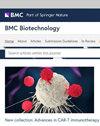利用银纳米粒子合成的表皮粘液蛋白阻止微生物病原体的生物膜和癌细胞系的发展
IF 3.5
3区 生物学
Q2 BIOTECHNOLOGY & APPLIED MICROBIOLOGY
引用次数: 0
摘要
尽管鱼皮粘液是免疫系统的一个组成部分,但科学家对鱼皮粘液的内在机制知之甚少。鱼皮粘液是抵御入侵性感染的重要组成部分。最近,鱼皮及其粘液越来越受到免疫学家的关注。研究人员通过紫外-可见光、傅立叶变换红外光谱、X射线衍射、TEM和扫描电镜对获得的银纳米粒子Ag与鲶鱼表皮粘液蛋白(EMP-Ag-NPs)进行了表征。Ag-NPs 大小为 4 至 20 nm,呈球形,角度分别为 38.10°、44.20°、64.40° 和 77.20°,EMP-Ag-NPs 形成后波长变化为深棕色,在波长 391 nm 处记录到宽带。此外,还对 EMP-Ag-NPs 的抗菌、抗生物膜和抗癌活性进行了评估。本研究结果表明,EMP-Ag-NPs 对单细胞真菌白僵菌具有很高的活性,其次是粪大肠杆菌。抗生物膜结果表明,EMP-Ag-NPs 对金黄色葡萄球菌和铜绿假单胞菌病原体都有很强的活性,其活性呈剂量依赖性,且不影响浮游细胞的生长。此外,还研究了 Ag-NPs 对正常细胞(Vero)、乳腺癌细胞(Mcf7)和肝癌细胞(HepG2)的细胞毒性作用,浓度为 200-6.25 µg/mL。目前的结果表明,浓度为 100、5 和 25 µg/mL 的 Ag-NPs 对 Mcf7 和 HepG2 有很强的抗癌作用,其 IC50 分别为 19、34 和 31.16 µg/mL。而 Vero 细胞在浓度为 50 µg/mL 时呈圆形,在浓度为 25、12.5 和 6.25 µg/ml 时呈正常形状,IC50 为 35.85 µg/mL。这项研究证明了生物生成的 Ag-NPs 作为替代药剂对有害微生物的潜在功效。此外,该研究还强调了 Ag-NPs 对癌细胞株的抑制作用。本文章由计算机程序翻译,如有差异,请以英文原文为准。
Hindering the biofilm of microbial pathogens and cancer cell lines development using silver nanoparticles synthesized by epidermal mucus proteins from Clarias gariepinus
Scientists know very little about the mechanisms underlying fish skin mucus, despite the fact that it is a component of the immune system. Fish skin mucus is an important component of defence against invasive infections. Recently, Fish skin and its mucus are gaining interest among immunologists. Characterization was done on the obtained silver nanoparticles Ag combined with Clarias gariepinus catfish epidermal mucus proteins (EMP-Ag-NPs) through UV–vis, FTIR, XRD, TEM, and SEM. Ag-NPs ranged in size from 4 to 20 nm, spherical in form and the angles were 38.10°, 44.20°, 64.40°, and 77.20°, Where wavelength change after formation of EMP-Ag-NPs as indicate of dark brown, the broad band recorded at wavelength at 391 nm. Additionally, the antimicrobial, antibiofilm and anticancer activities of EMP-Ag-NPs was assessed. The present results demonstrate high activity against unicellular fungi C. albicans, followed by E. faecalis. Antibiofilm results showed strong activity against both S. aureus and P. aeruginosa pathogens in a dose-dependent manner, without affecting planktonic cell growth. Also, cytotoxicity effect was investigated against normal cells (Vero), breast cancer cells (Mcf7) and hepatic carcinoma (HepG2) cell lines at concentrations (200–6.25 µg/mL) and current results showed highly anticancer effect of Ag-NPs at concentrations 100, 5 and 25 µg/mL exhibited rounding, shrinkage, deformation and granulation of Mcf7 and HepG2 with IC50 19.34 and 31.16 µg/mL respectively while Vero cells appeared rounded at concentration 50 µg/mL and normal shape at concentration 25, 12.5 and 6.25 µg/ml with IC50 35.85 µg/mL. This study evidence the potential efficacy of biologically generated Ag-NPs as a substitute medicinal agent against harmful microorganisms. Furthermore, it highlights their inhibitory effect on cancer cell lines.
求助全文
通过发布文献求助,成功后即可免费获取论文全文。
去求助
来源期刊

BMC Biotechnology
工程技术-生物工程与应用微生物
CiteScore
6.60
自引率
0.00%
发文量
34
审稿时长
2 months
期刊介绍:
BMC Biotechnology is an open access, peer-reviewed journal that considers articles on the manipulation of biological macromolecules or organisms for use in experimental procedures, cellular and tissue engineering or in the pharmaceutical, agricultural biotechnology and allied industries.
 求助内容:
求助内容: 应助结果提醒方式:
应助结果提醒方式:


